Seven Dining Table Buying Tips
With its durability, style, and functionality, it is sure to be a focal point in your dining room for years to come.


Choosing the perfect dining table
If you are like most of us, you probably don’t buy a new dining table every six months. You will use yours for anywhere between 5 and 10 years. So, choosing your dining table shouldn’t be done in a hurry. To help you make the right decision, we’ve put together this dining table buying guide.
Step 1: Measure your space.
Don’t fall in love with a design, only to have to “figure out” ways to make it work. Save yourself the time (and heartache) and instead establish the workable space into which your new dining table must fit. Measure the length and width of your allocated space. Then subtract 3-4 feet from each dimension. Why? To avoid a cramped and unwelcoming dining environment, your table will ideally need around one foot of space on all sides. If you have a very small room or a space with changing uses, consider a convertible design: one that can transform into a coffee or console table, for example.

Step 2: Get in shape.
This isn’t set in stone but, like it or not, certain table shapes just work better within certain room shapes. The rule of thumb is: square and circular table tops do well in square rooms, but they will look and feel awkward in rectangular spaces. Rectangular and oval-shaped tables best suit rectangular rooms, but will look and feel awkward in square spaces.

Step 3: Build a mock-up.
If you have a shortlist of table shapes and sizes, but are still unsure, this could help. Measure and mark out the table top on the floor with magazines. Then arrange dining chairs as they would stand. Pull out a chair. Sit down. Walk around. Use this simple and inexpensive trick to get an idea of how you, the table and the room will interact.

Step 4: How will you use it?
Will sitting at the table be reserved for weekends and dinner parties? Maybe an extendable design, which is relatively space-saving when off-duty, could be your best choice. If your table will get a lot of daily action, maybe doubling as a desk, we would suggest a highly durable table top material. Choose heat-proof, scratch-proof ceramic, solid wood or glass, but choose tempered glass, as it is super-strong and scratch-resistant. Veneer can also provide years of durable service but be sure it is real wood veneer and thin, too, as with time, thick veneer can be prone to peeling away.

Step 5: Choose color cautiously.
Color is an important element in the orchestration of a fabulous home, but the longevity of a dining table means it must be able to work across changing themes. Staple hues like black, gray, brown and white will always be on trend. They will also work as dependable backdrops to whatever trend colour you happen to love this season. Do you share your space with crayon-wielding toddlers or boisterous pets? Then we would suggest you avoid matte white and light woods.

Step 6: Don't overlook the base.
It can seem like a merely esthetic decision, but the base of your new dining table will affect the way you use it. If you intend to regularly maximize seating on a small table, opt for a design with a pedestal base, to avoid diners hitting their knees on table legs. Pedestals are also great at freeing up space in a small room. Large table tops can promise ample space yet snatch it away with a cumbersome frame. There’s only one way to weed out these deceptive design flaws.

Step 7: Try it out ... thoroughly.
Of course, we are big fans of online shopping, but we would recommend trying out tables in stores. We imagine your family members, like ours, come in different sizes, so bring them along, too. Sit, stroke surfaces, move chairs around, try out extendable leaves, check for signs of wear. This is likely to be one of the hardest working pieces in your home, so take…your…time.
